This is part of Discourse 2000, a story-by-story exploration of the weekly comic 2000AD. Includes spoilers!
WHICH THRILL?: Gigantic polar bear Shako gets unwittingly involved in the Cold War when a secret CIA project gets lodged in his stomach.
ACTION MEN
2000AD has been running for close to 50 years, but there’s been surprisingly little critical movement in that time around its agreed high and low points. We’ve seen a gradual deepening of the appreciation for Judge Dredd as a work of highly perceptive satire – culminating in this year’s Eisner win for Michael Molcher’s excellent I Am The Law, which puts Dredd in conversation with the history of policing and “law and order” politics. There’s also been a much greater appreciation of 2000AD’s place in a wider universe of British comics, with titles like Misty and Scream getting their critical flowers after years mostly forgotten. And of course there’s been the general relief that Rebellion have kept the Prog going, and going to a high standard, so that the nostalgic old bores (me included) don’t have it all their own way.
What there hasn’t been, though, is much of a shift in attitudes to 2000AD’s ‘canon’ of acknowledged classic strips: Dredd, Nemesis, Halo Jones, et al. The canon is additive – you’ll occasionally get a Nikolai Dante, a Zombo or a Brink muscling their way in among the legends – but it’s rare for an older strip to move much beyond readers’ initial verdict. One of the central reasons for doing this blog is that there’s a lot of 2000AD work nobody’s paid critical attention to in years, and it has the potential to put the classics in an interesting light. But I’m not expecting to read Rick Random and come out hailing it as a lost gem.
Over the last couple of years, though, Rebellion have addressed the canon question head-on, with a set of Best Of 2000AD compilations presented as “mixtapes” drawing on the whole 45+ years of 2000AD history, judiciously putting the best of the modern thrills alongside representative jewels from the past in order to say, yes, the new stuff absolutely can hold its own. It was an award-winning success.
But what’s interesting about the Best Of is that it’s both a conscious attempt to build a modern canon and a sly go at remixing the older one. Yes, Halo and Nemesis are present and correct. And there’s a Judge Dredd in every volume, but a lot of the picks are connoisseurs’ selections like 1983’s “The Graveyard Shift”. But the most extraordinary choice is the oldest comic in the collection, the sole representative of 2000AD’s first year: a sequence of episodes from polar-bear-on-the-rampage story Shako.
If a time traveller from 2024 had shown up in the 2000AD office at the end of 1977 and told them the comic was still going, staff and management would have been floored. But you’d have elicited almost as much disbelief if you’d told them the people printing it thought the high point of their work so far was Shako. Shako is very short (the strip; the bear is a whopper) and even so wasn’t reprinted in full until 2006. It’s barely science fiction – the one SF element is a MacGuffin the story has completely forgotten about by the end. Below the surface it’s a retread of the themes of Hook Jaw – man against nature, with nature represented by an apex predator in its natural environment – and Flesh – a story of a mighty beast fighting back against destructive colonisers. And on the surface it’s a victim-of-the-week schlockfest.
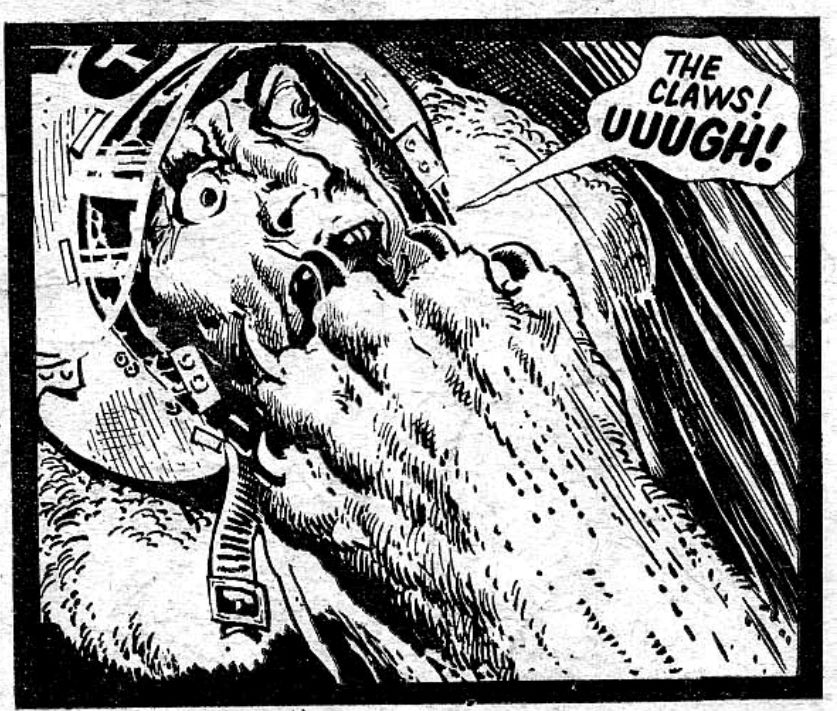
But Rebellion aren’t reprinting this to be ironic, or even just as a broad example of What 2000AD Used To Be Like (though it works well as that). Shako is brilliant. It finds a new, darkly comic voice for 2000AD which we’ll see again and again, even if it’s rarely as crude or gonzo as this. And I’d argue it represents a break from, even a laying to rest of, 2000AD’s main influence, the comic I’ve mentioned in almost every one of these write ups: Action.
Action’s story has been told almost more often than 2000AD’s, first and still best in Martin Barker’s Action: The Story Of A Violent Comic. Barker told the story of how Pat Mills, and co-conspirators like editor Geoff Kemp and writers John Wagner and Ken Armstrong, concocted a comic that suited its febrile, aggressive times, lifting wantonly from TV and films to create stories young readers would relate to in ways rival comics couldn’t touch. Launched in February 1976, Action is very clear about its loyalty to its readers and their lives – “REMEMBER”, read messages at the bottom of the page, “ACTION IS ON YOUR SIDE”.
The comic drew adverse attention almost immediately. Action was pilloried in the national press, and as its contents got even hotter and more controversial, IPCs John Sanders faced a grilling on National TV after the notorious “Kids Rule OK” cover seemed to show a fallen policeman cowering from a chain-wielding hooligan, and weeks later the comic was withdrawn from sale without consulting Sanders; it returned in December 1976 in painfully diluted form.
Action was hardly alone. Outrage and distress over violent media – particularly for children – was on the rise. Weeks after the final pre-clampdown issue of Action (cover tagline: “COMMIT SUICIDE”) was pulped, Mary Whitehouse of the National Viewers and Listeners Association complained about an episode of Doctor Who and was heard, a link in a chain of events which ended in producer Philip Hinchcliffe leaving the job. Weeks after that, the Sex Pistols swore at Bill Grundy and the country exploded in highly mediated anger around punk rock. A comic like 2000AD launching in early 1977 was entering a very different media environment than Action a year earlier.

Thanks mostly to Martin Barker, the story of Action is very familiar. But for all the intense loyalty of its horde of readers, Action was little noticed by any wider comics public. There’s no discussion of Action, or the scandal around it, in contemporary fanzines, and when Pat Mills mentions the controversy, and Action’s emasculation, to a fanzine five years later, the interviewer, well versed in 2000AD, had no idea its predecessor even existed.
Barker’s book brought Action back to prominence and established its legend, and the generous quantities of strips he reprinted gave readers a valuable sense of what the comic was like. To actually read Action, though, is to experience a comic that’s rather different from the all-mayhem, boundary-busting title you might have read about. It somehow is both less and more extreme than you’re expecting.
The best of early Action – Hook Jaw, Fugitive-style thriller The Running Man, and particularly hardman secret agent Dredger – still crackles with confidence and aggression, balanced with the skill to make the stories hit over just 3 or 4 pages. Pat Mills described later how difficult writing Dredger was – done-in-one action thrillers which had to crank through backstories, antagonists and twists with merciless efficiency. But the work shows – I came to Dredger, my favourite Action strip, after reading the similar MACH 1 and was floored by its sophistication in comparison, the tautness of the stories and the level of imagination with which Dredger handles each deathtrap and double-cross. And yes, the strip involves startling levels of violence, presented with a sadism which early 2000AD mostly avoided. By Action issue 3 we have a wince-inducing opening panel where Dredger is being tortured in a dentist chair, for instance. In an example of the plotting and twists the series delighted in, he’s letting himself be tortured to draw suspicion from a double agent, who he ends up shooting anyway.
But elsewhere Action is very much an ordinary comic. The shock value of Hellmann Of Hammer Force – a war comic with a German hero – wears off quickly and it’s mostly interesting for how much the story contorts itself to reassure you that while Hellmann is racing through France at the head of the Nazi war machine he doesn’t, you know, agree with it or anything. Other stories are routine, feeling a decade out of date next to the fresher material, though one of the reasons Action impresses is how ruthless and shrewd it is about identifying and purging weaker features – lifeless sports blackmail story Play Til You Drop and the soporific Coffin Sub are gone within a few months, to be replaced by strips more in line with Action’s two-fisted brio.
One was Death Game 1999, a Rollerball crib that’s an obvious Harlem Heroes ancestor and Action’s only attempt at science fiction. When you look at Action as a 2000AD predecessor, it’s worth thinking about the other elements Mills and company carried over to the new title and the ones they left alone. MACH 1, as mentioned, is very Dredger-influenced, but Bill Savage’s team-up with Peter Silk also echoes Dredger’s relationship with Eton-educated Simon Breed. The bloody rivalries of the men trying to hunt Hook Jaw recur in the uneasy alliance of Regan and Carver in Flesh. But Dan Dare owes little to Action, and Dredd is a knowing inversion of its anti-authoritarian streak – who could object to post-apocalyptic brutality when it’s done by the police?
But some parts of Action don’t travel to the new launch. The streak of up-yours social realism that animates Action doesn’t cross over – the greasers, petty crooks, gangs and skins who sometimes hassle but sometimes support the protagonists all melt away in early 2000AD, and it’s years before we see much like them. Even more than the violence, that shift in tone is the big difference, suggesting to me that it was the sheer bolshiness of Action that put the wind up the establishment, as much as any of the red ink sloshing around. And it’s a shame to lose it – those parts, on show in strips like Sport’s Not For Losers and Look Out For Lefty, are where Action is at its funniest.
GRRR-INDSET MENTALITY
The idea that Shako is a break from the Action legacy may seem a very odd claim to make, as the story is obviously conceived as an equivalent to Action’s main attraction, the monstrous killer shark Hook Jaw. In the first 2000AD Annual, released while Shako was still running in the prog, the bear gets an origin story, “White Fury”, which positions it very much in the spirit of the great white. Shako is a creature driven by instinct and urges but also by hatred of the humans who slay his mate and cubs, and a preternatural cunning which allows him to pull off quite astonishing stunts. In “White Fury” he manages to casually sink an entire ship before swimming off.
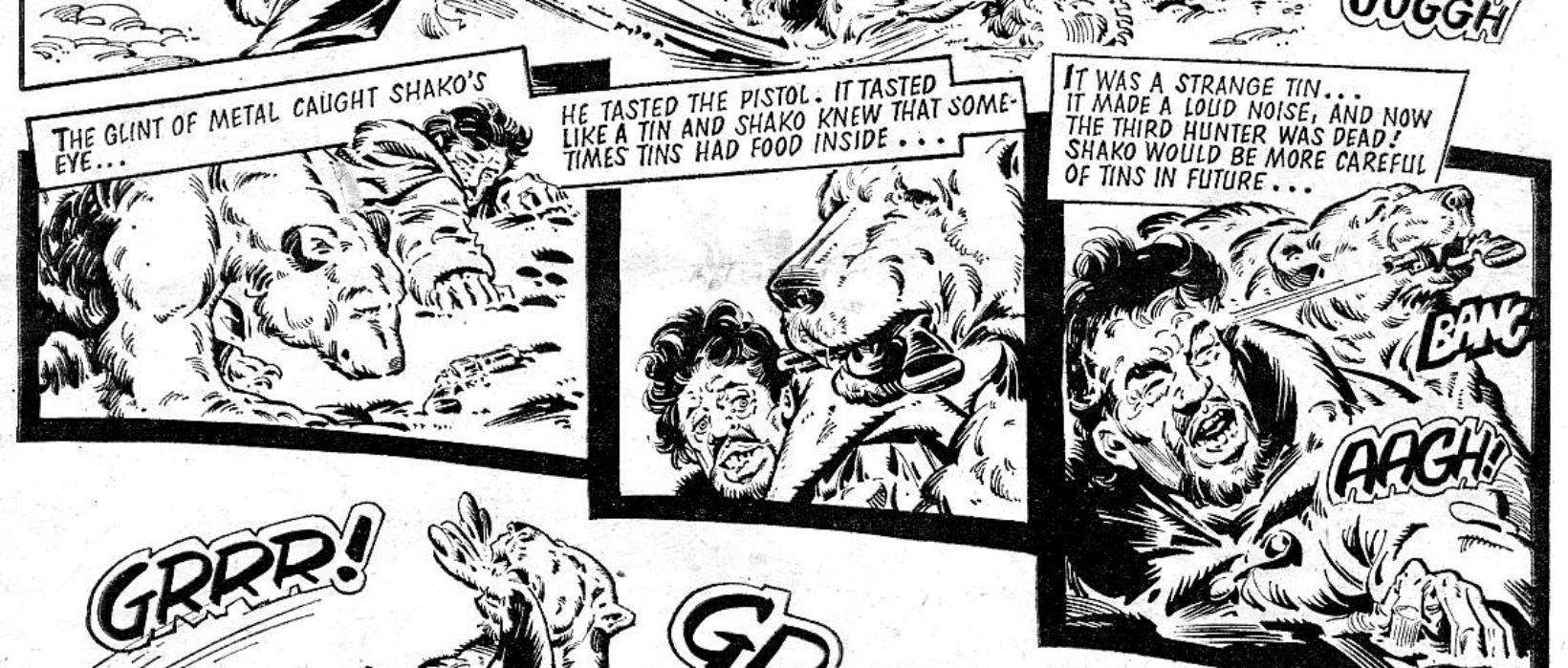
But the way in which Shako is able to move on from Action is in finding a way to recapture the biggest thing left behind when 2000AD launched – Action’s dark streak of humour – and make it work in the new comic’s context. The first four episodes of Shako itself are by John Wagner and Pat Mills, working off a concept Mills created for the original dummy issue of 2000AD. They introduce a very familiar set of characters – CIA agent “Foul Mouth” Falmouth, a take-no-prisoners tough guy, who’s working with the calmer, more ethical Buck Dollar, a “half-Eskimo ecologist” to bring down the rampaging Shako. To complete the Jaws triangle of authority figure, scientist, and wild man we briefly also get a drunken sailor, who, like almost all the named characters, winds up meeting his end at Shako’s jaws, though not before he’s got the polar bear drunk.
Already this feels like a more cynical speedrun through the Flesh and Hook Jaw playbook – Falmouth is written as a gibbering maniac, and you don’t call a character Buck Dollar if you’re taking matters completely seriously. And it’s very apparent, very quickly, why Shako missed the cut for the original line-up: the premise is unsustainably bananas. Corporate cowboys versus Tyrannosaurs feels like a fair man against nature fight; the might of the US military and intelligence services versus one polar bear does not, and to make it one you have to make the humans hunting Shako into the most astonishing bunch of idiots. Which Wagner, very happily, does.
This is at the heart of why Shako was seen as, at best, a weird, forgotten mis-step until about 20 years ago, when adult fans rediscovered it and realised they were reading a classic. For all Mills’ dedicated and useful research on the habits of polar bears, as a concept Shako feels too simple: Hook Jaw except it’s a bear, so what? And because Shako was by early 2000AD standards very short, and because it was hardly reprinted, that concept is all people really had to go on: in nostalgia terms it ranked somewhere below Ant Wars. But reading Shako it’s immediately obvious that everyone involved, most especially John Wagner, knows exactly what they’re dealing with. The most famous Shako anecdote is that when Wagner handed in the script, its opening line was “Christ! Look at the size of that fucking bear”. On one level Shako is ridiculous, and Wagner knew it.
But Shako is never pitched as an outright comedy strip, and it wouldn’t be as good if it was. It’s a revenge saga which is also a comment on cold war politics, with Americans blundering and slaughtering their way across a wilderness that was doing just fine without them. But it’s also full of very funny moments: it’s a Millsian theme told with Wagnerian (no, not that Wagnerian) comic relish. Before its rediscovery it was dismissed as a poor retread of Flesh and Hook Jaw, when if anything it’s a satire of the previous stories. Or perhaps more accurately, Flesh treats its man vs nature theme as hubristic tragedy; Shako repeats it as farce.
You can see this most obviously when you compare the sequences in each story where the central monster rampages through the humans’ base. In Flesh, the siege of the Trans-Time base is the climax of the story, ramped up to for weeks and played for thrills, scares and big symbolic moments. In Shako, the bear’s assault on the Ice Station community is full of slapstick and black humour, like the scene – good enough that Wagner riffed on it in an early Judge Death story – where the base commander, written as a Southern hick, gropes his way out of the shower and compliments his wife on an unusually soft towel. What the reader knows and he does not is that really it’s Shako’s pelt.
The scene is drawn by Flesh and Hook Jaw veteran Ramon Sola, the go-to artist for death-by-creature, though most of Shako is drawn by the more placid Juan Arancio (who does do a satisfyingly chonky bear). Sola gives us a twisted, brilliant image of the hapless, naked commander being torn to actual ribbons while helpfully telling us “He’s ripping me to shreds!”. This is a favourite trick of Wagner’s, heightening the grotesquerie by having Shako’s victims narrate their own horrific demise, usually to no other character, like a pantomime actor addressing the audience. Sola’s wild, expressionist mayhem aside, most of Shako’s art is not actually very bloodthirsty, so this technique is a way to emphasise the violence in Shako. But it’s also inherently absurd.
And it has to be. For all that Hook Jaw and Flesh are both classics, there are barriers to making the Jaws-style killer-animal subgenre work well as a comic for kids. Jaws gets its power from the control film has over pacing and shock, as well as from the gory violence. The control is lost in the transition between mediums – weekly comics have the blunt-force tension-generator of the cliffhanger, but it’s hardly the same as a well-executed jump scare. The gore was preserved in Hook Jaw via its position in Action’s full-colour centre spread, allowing copious amounts of red ink to titillate the reader.
But 2000AD doesn’t have that luxury, and besides can’t risk the same kind of publicity Action’s violence generated. Without shocks and blood, killer-beast stories are toothless. Mills finds a way around that with Flesh, by creating an actual plot and a world to frame his hungry Tyrannosaurs, letting him oversee the strip as a single, accelerating story. Wagner in Shako finds what’s probably the only other way to do one in early 2000AD – write it as ultra-dark comedy which takes the bits everyone already knows, like the obsessed human protagonist, and presents them in as over-the-top a way as possible.
Wagner’s first solo credit on the strip is part 5. This is the episode with the unsurpassable tagline, “The only BEAR on the CIA DEATH LIST”, but it’s also the episode where Shako spends his time chasing a CIA agent and biting all his clothes off one by one, while Falmouth gets chased in turn by a version of Nurse Ratchet from One Flew Over The Cuckoo’s Nest, and ends up getting an injection from a massive syringe in his bare bum. Illustrating this is Italian artist Doggerio, whose rendering is by early 2000AD standards subtle and delicate, and really hampered only by how very weird his bears look. Which would be a problem if he was the regular artist, but actually works to emphasise how strange the story you’re reading is.
It surely wasn’t obvious at the time, but this episode, less than six months into the comic’s life, is where the original style of 2000AD – what I’ve been calling “Sweeney-Fi”, working-class tough guy adventure with a SF spin – starts to make way for something new. We know from Flesh that the real protagonist of a creature strip is the creature, but in Flesh there’s an effort made to give Old One Eye a Millsian counterpoint in Earl Reagan, the hard man out on the frontlines who understands the threat and is willing to take his bosses on to deal with it. Falmouth is in that narrative position in Shako, but Wagner takes every opportunity to make him look a fool, constantly sparring with his ambitious (though equally incompetent) second in command Dobie.
Buck Dollar, the ecologist, behaves more reasonably – and as the guy sympathetic to nature you’d expect the strip to take his side – but his actual actions are shown to be disastrous until the very end: without his plan to capture the “magnificent specimen” Shako and release him alive, Falmouth would have his capsule and the story would be over in three weeks. Dollar and the other Inuit characters in the story are better able to understand and deal with Shako than the Americans, but Wagner doesn’t completely buy into the “native wisdom” stereotype either. The final episode of Shako makes great play of Buck Dollar hunting Shako the traditional way, with ceremonial robes and a war cry – it fails to kill him, and the mortally wounded Dollar eventually has to use an enormous bazooka.
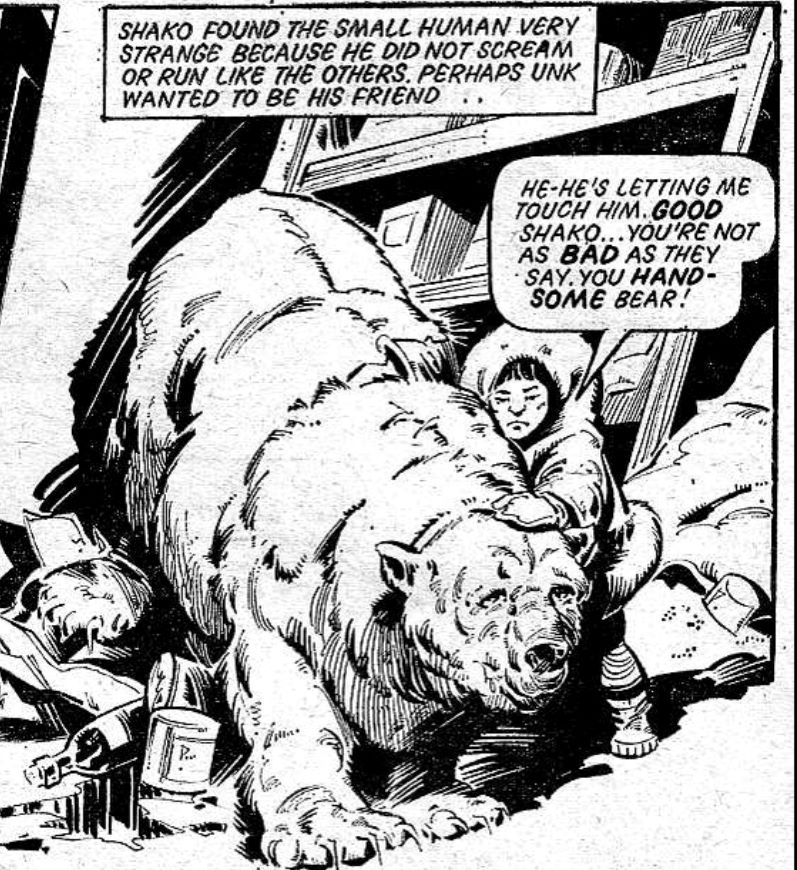
Tragedy vs Farce: in Flesh, man loses because we underestimate the power of nature. In Shako, man loses because we are thick as shit. It’s not yet apparent in the way he writes Judge Dredd, but for all that John Wagner is extremely good at writing superhumanly tough characters, he has a very clear-eyed view of the limits of toughness, and it’s on display in Shako.
What we’re seeing here becomes, for a long time, the dominant tone of 2000AD – a mix of visceral, over-the-top action and black, cynical humour. It works better when it’s allied to wilder sci-fi concepts, as in Wagner’s work on Dredd and later Strontium Dog, but early on 2000AD doesn’t have many of those, so we see it here, taking a tough-guy versus animal strip and twisting it into something truly surreal. In the 2000AD style, the humour and the action intensify each other, creating the sense you’re in on something subversive, something you can’t quite believe they’re getting away with.
It takes a while longer for this nasty, funny tone to show up in the Prog regularly, but once it does it becomes the style most associated with “Golden Age” 2000AD. And alongside Dredd, Shako is where it starts. Or at least, the first half of Shako; there are only so many episodes you can squeeze out of people failing to kill a big bear, and while the later parts of Shako, involving a tussle with the KGB, are entertaining, when Buck Dollar and Shako have their final showdown it doesn’t feel premature.
“Shako died well!” – and with him ends the Action era of 2000AD, where the comic exists as a continuation of that earlier project, even if that wasn’t obvious to fans. What I’ve been calling the Sweeney-Fi style was vital to the early concept and success of the Prog, though, and it never disappears entirely. The tough-guy anti-authoritarian streak is in the comic’s DNA, mutating and recurring across genres and eras. We’ll keep seeing strips for a while with contemporary or very near future settings, which Sweeney-Fi works best in, but it’s several years before we get another that stands as a high point for the comic. By the end of 1977, the most successful parts of 2000AD feel increasingly distant from the stories in Prog 1.
Whatever its successes as a style, though, Sweeney-Fi was vital as a way of bridging the gap between what Mills and others had done on Battle and Action and what 2000AD became. In a world where SF was a potential coming trend rather than a sure thing, that bridge reflected where readers (and IPC management) were. But it’s fitting that it’s Shako, the strip most obviously indebted to Action, that begins to call time on its way of doing things.
HOW TO READ IT: After a few reprints in magazines and collections Shako got its own full reprint in 2012, and I believe it’s still available on the 2000AD webshop.
RECOMMENDED? Yes! At least if you like Flesh. Even if you don’t agree with my wider arguments for its significance, it’s worth checking this early cult classic out.
NEXT PROG: Who has been bringing us all these thrills? Why – it’s Tharg The Mighty, and now he gets to star in a story of his own.


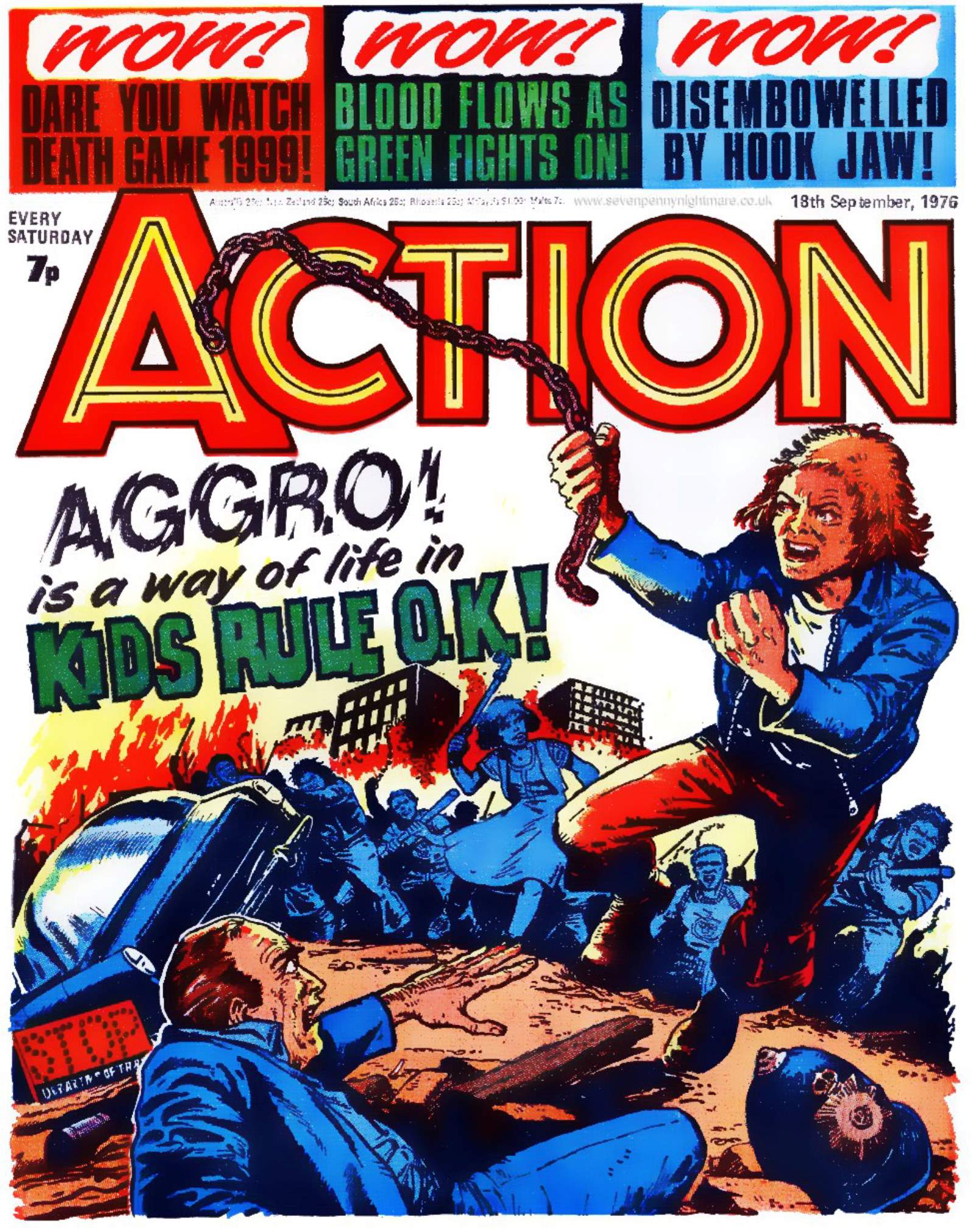
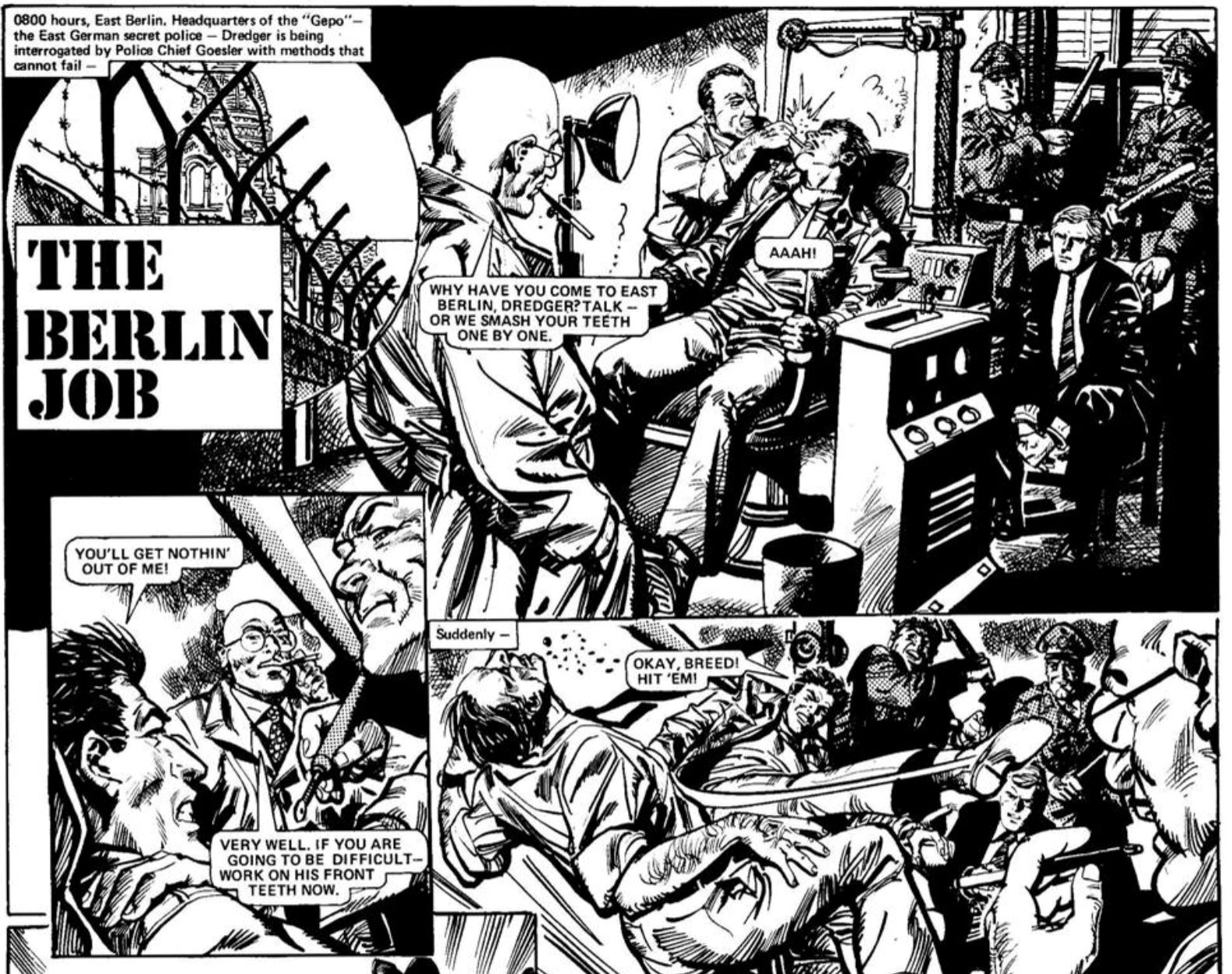
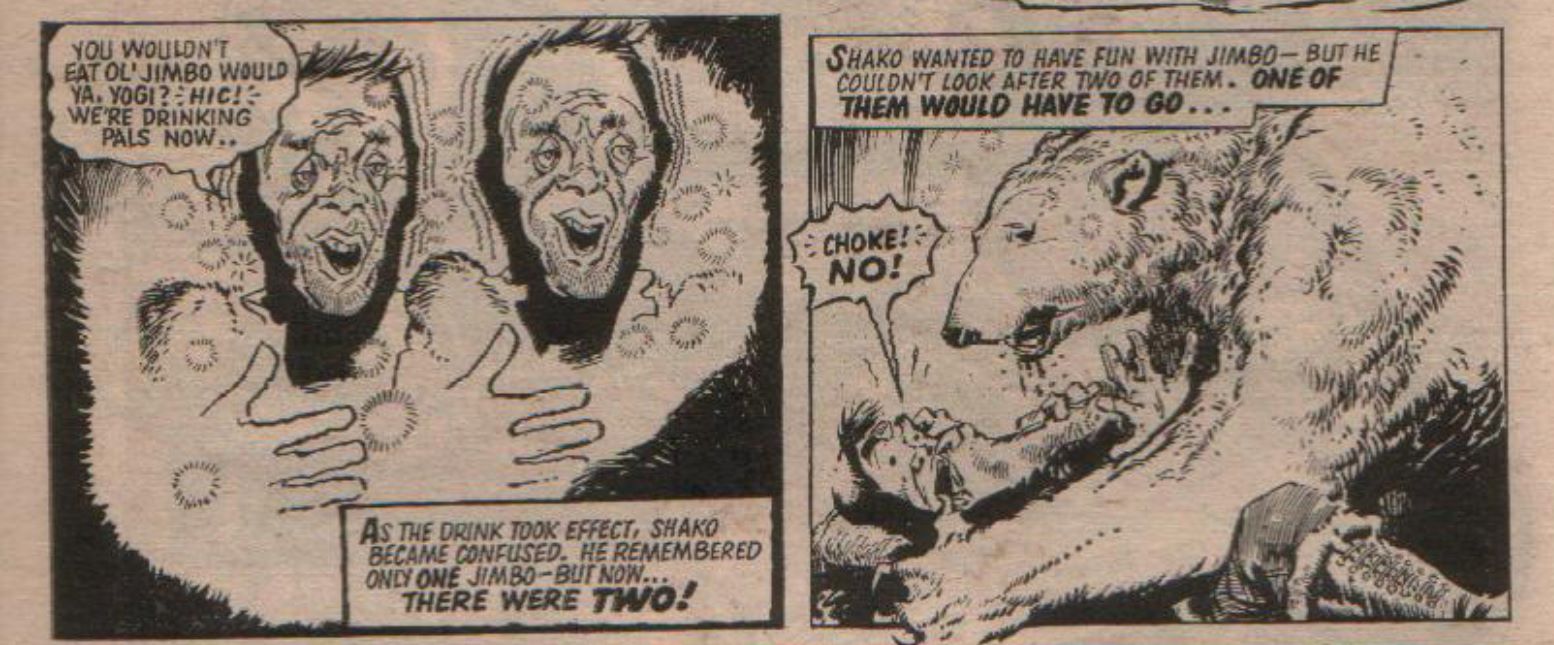

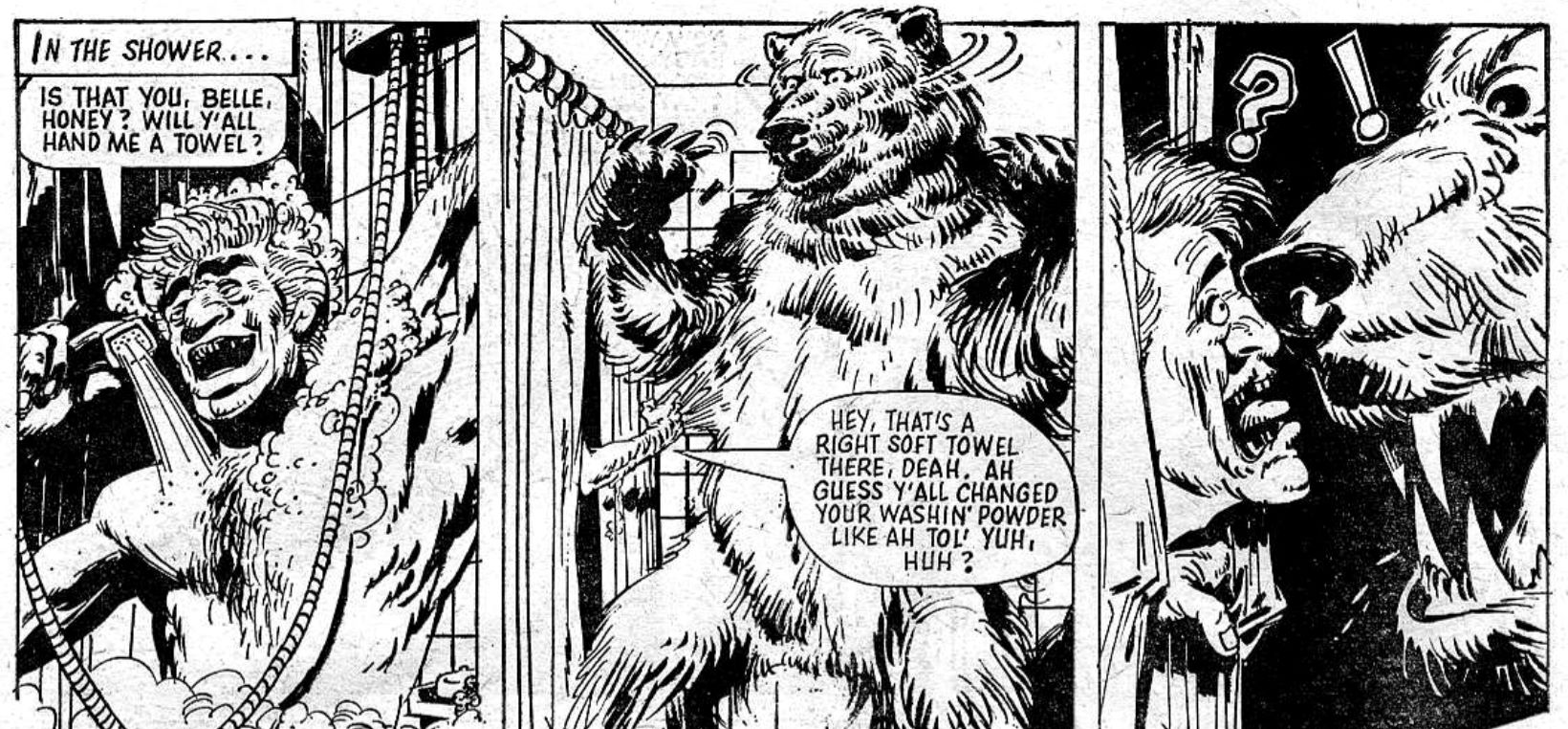
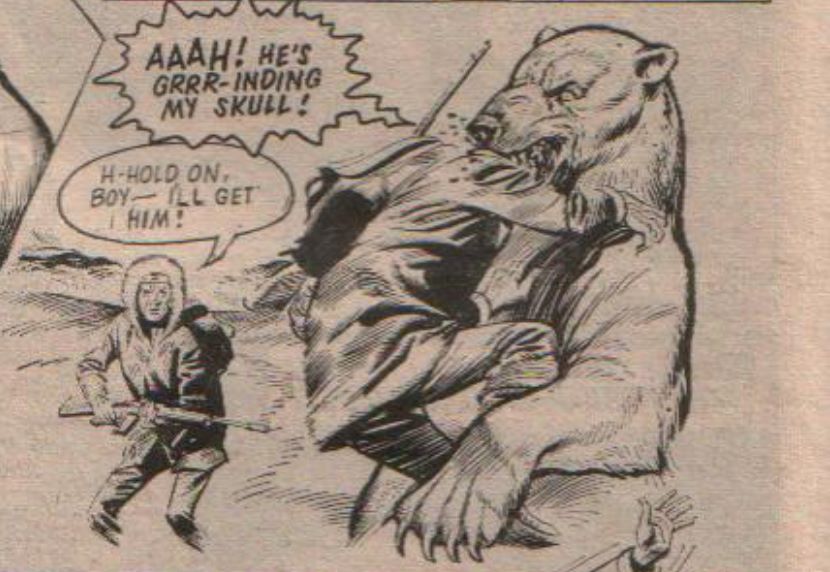
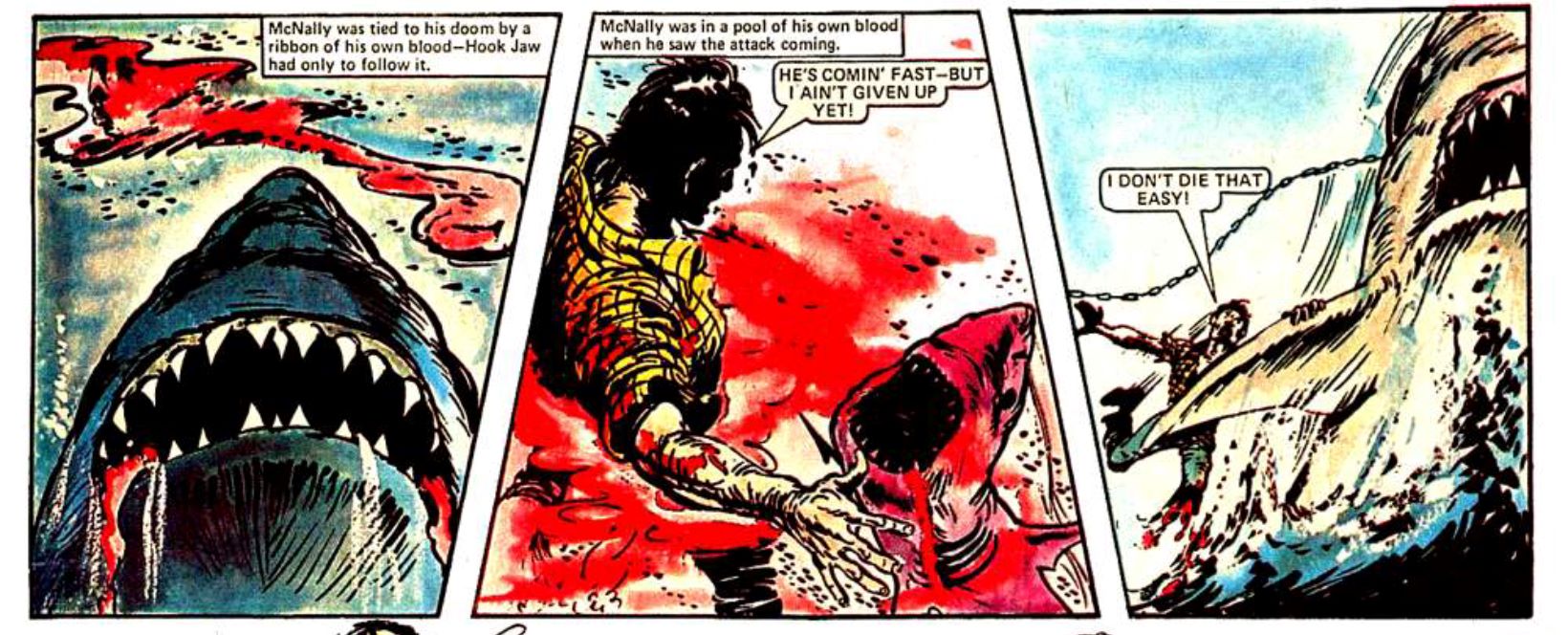
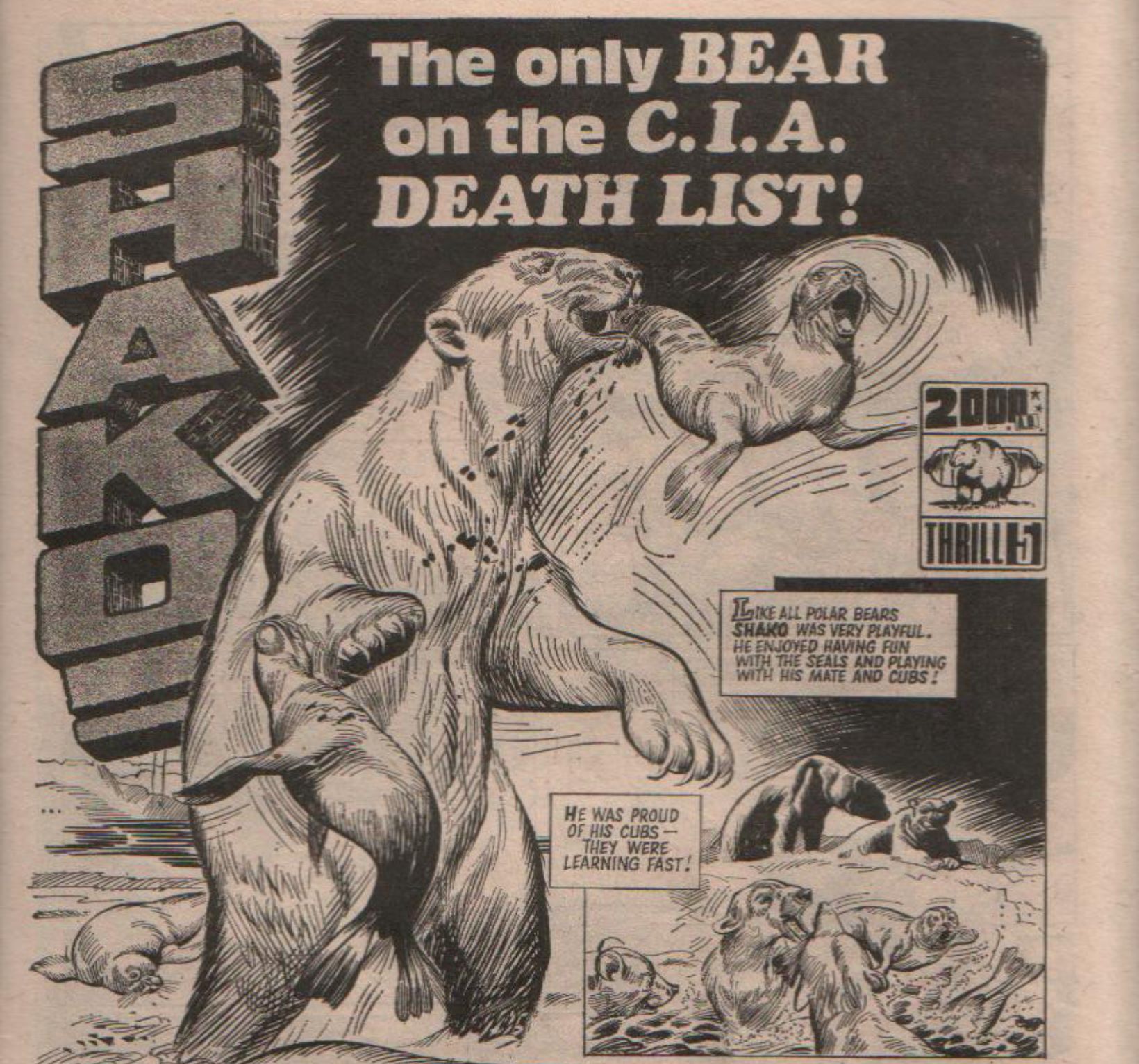
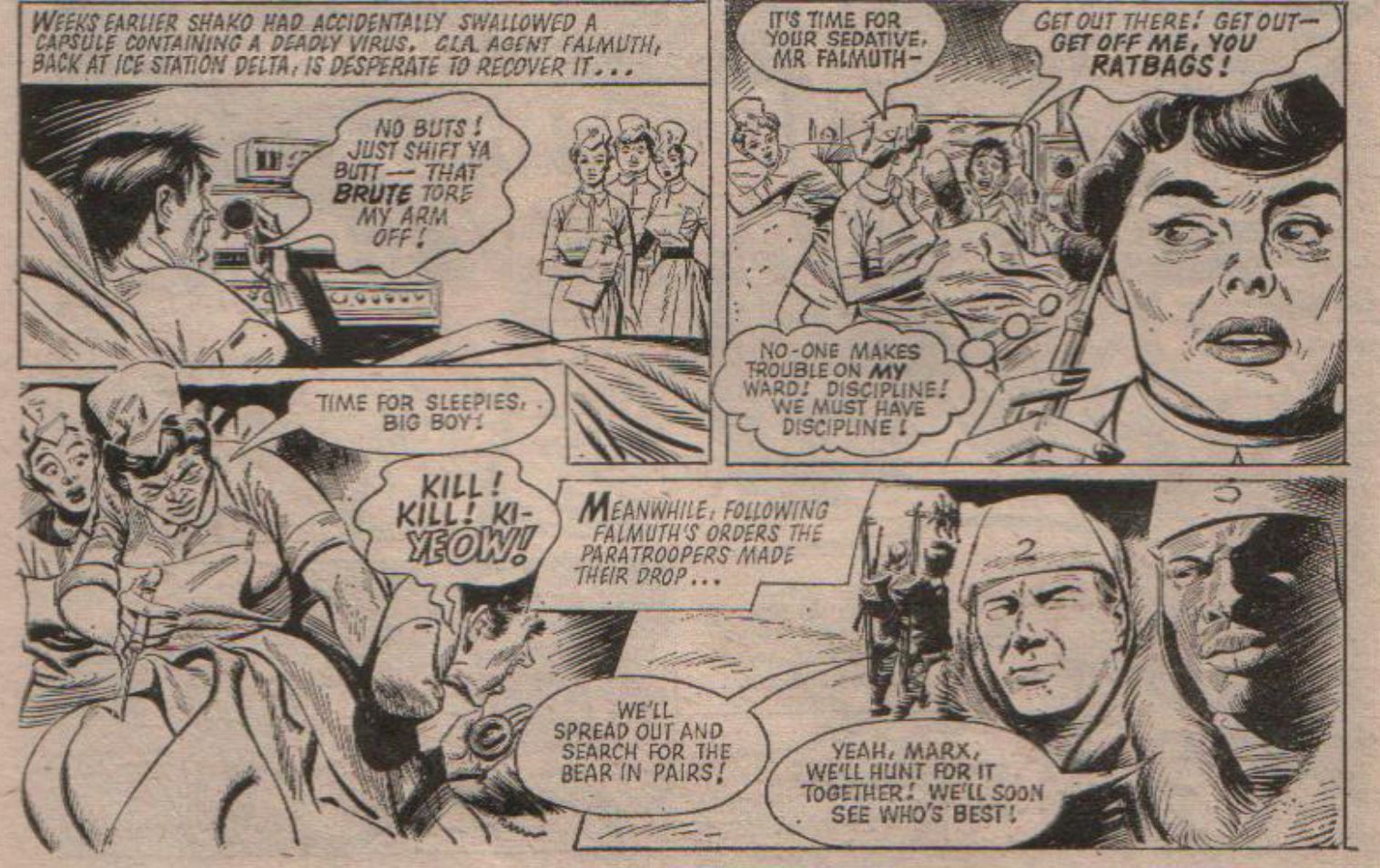

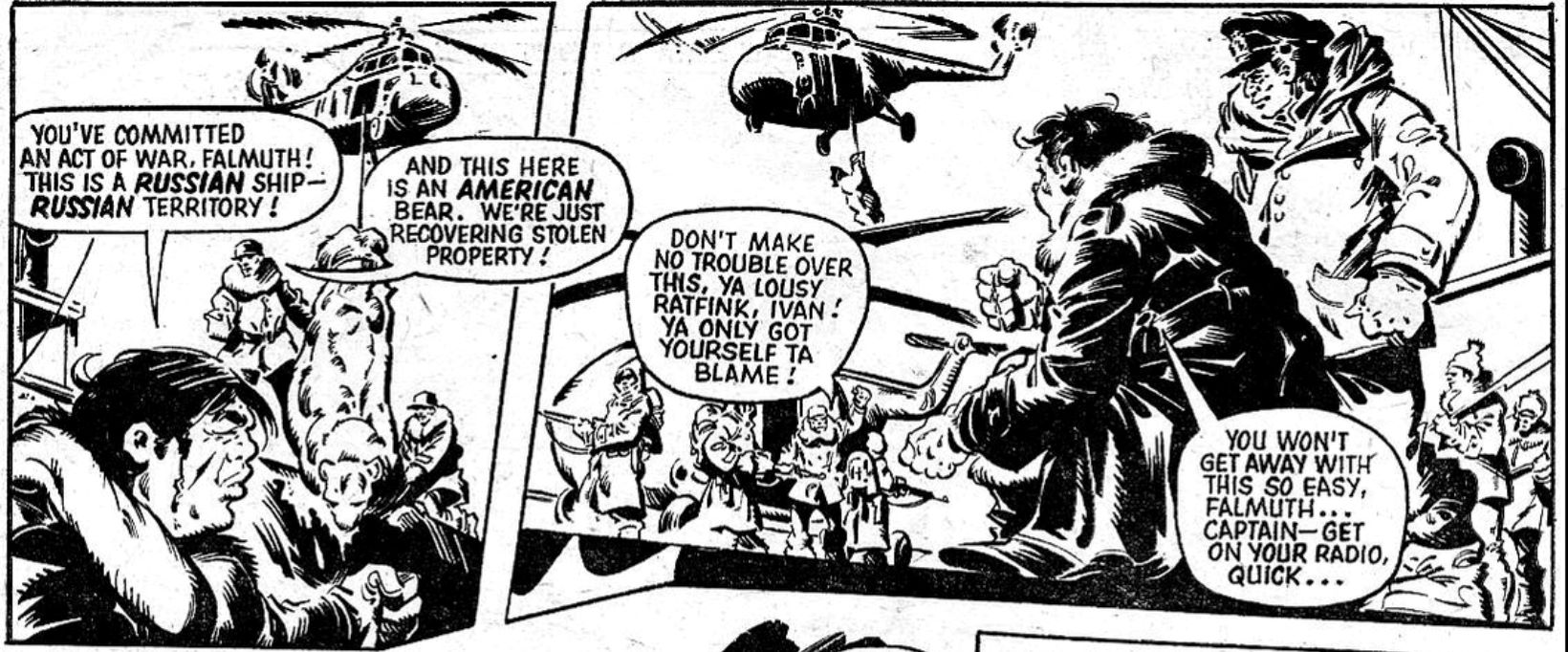
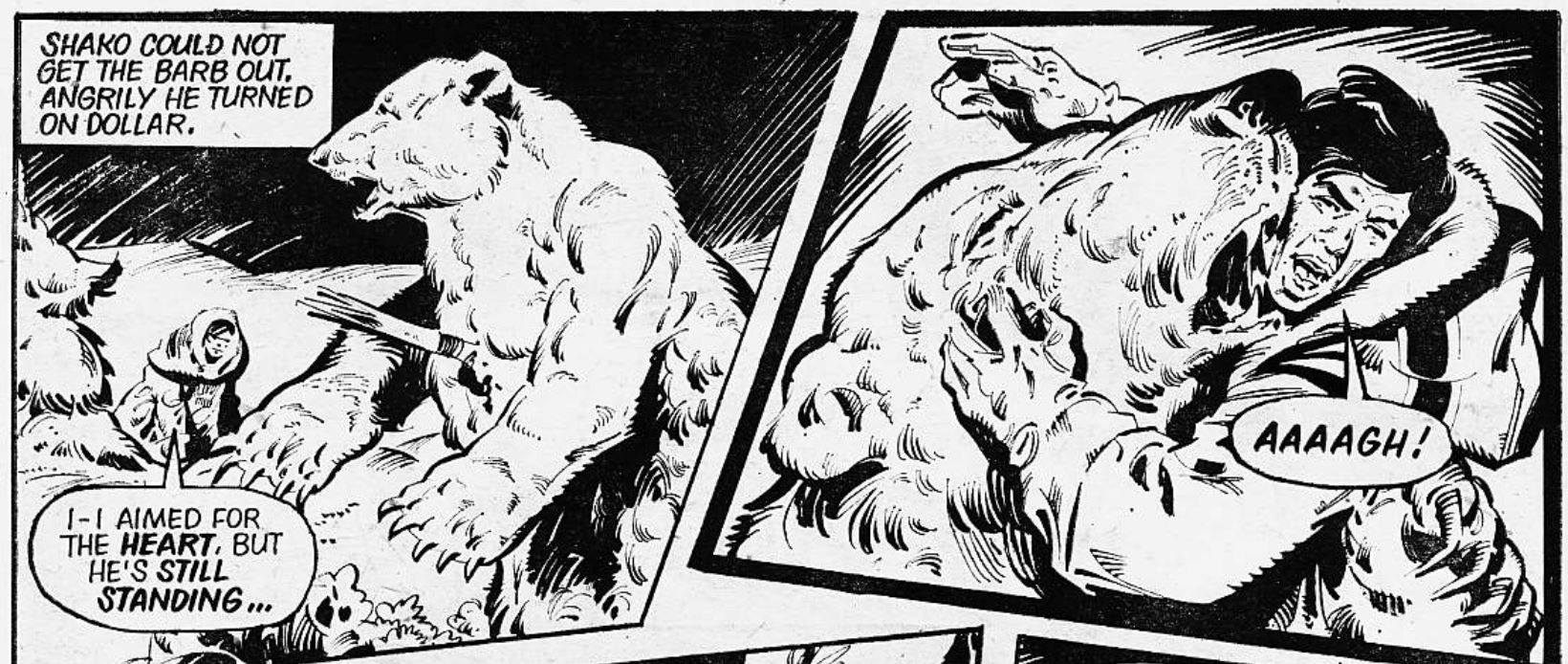

With Strontium Dog mentioned, how are you going to approach Starlord for the 1978 season? (Or Tornado, Diceman, Crisis, and Revolver later on, for that matter) Going for the exculively-2000AD-readers’ experience; covering only the 3 Starlord strips that cross over into 2000AD; or basically doubling your workload?
This is a great question and I haven’t quite decided.
The strips that cross over will get covered with the Starlord material included. Beyond that I’m thinking about either doing a post on Starlord in general which would include the stuff on the other strips, or doing side posts which would be much shorter. Diceman will get its own entry, probably centering on the title character with the other stuff mentioned in their own posts or alongside it. Crisis and Revolver are too far out to think about really but I’m vaguely planning on full entries for the Crisis stories at least.
Shako is my favourite 2000AD story that I’ve never in fact read. I love the concept, and even though it has clear ancestors (a bit of Hook Jaw, a bit of Shardik), it still feels like the sort of thing only 2000AD would do.
I surely read this at the time, and wish I could say I was a precocious kid who presciently loved it… but no, it was just standard IPC action fare as far as I was concerned. I’ll have to hunt it down for a re-read, though—looks grrr-eat.
It fascinates me to this day that the Boy Child seems to prefer Shako to Flesh.. I mean sure polar bears are cool and Shako is a great story, but… well… DINOSAURS!
Ahem, anyway. The idea that 2000ad had an Action period ending with Shako is kinda hard to deny from one hand BUT as you allude to the Sweeny-fi stories continue for a good while yet. It will be interesting to see which is the last such story. I have one in my mind without giving it enough thought (which seems dangerous around here! So much thought going on!).
Anyway my point was meant to be the period doesn’t so much end as slowly evolve out as the comic develops in my mind. I might amount to the same thing, but I look at the Starlord era and I think a case can be made there for through-threads if not direct lineage from Action?
Yeah it’s never as simple as a neat narrative like mine makes out! For one thing Savage is obviously back for 1979. Inferno is much more indebted to Action than Harlem Heroes was – so lots of exceptions. It’s more like an evolution of styles and genres which each become things 2000AD can do well, and often you’ll find the prog trying many such things in the space of a single issue. It’s probably fairly deep into the Starlord years, if not beyond, before you get a comic which doesn’t feel *anything* like Action used to.
so i dug out my one 2000AD annual from the dustier reaches of my bookshelves — evidently a birthday present from one of my then flatmates, noting the cheerful message on the opening endpaper — and discovered to my delight that a good deal of it is devoted to a complete reprint of SHAKO!